The following outline provides an overview of and topical guide to entertainment and the entertainment industry:
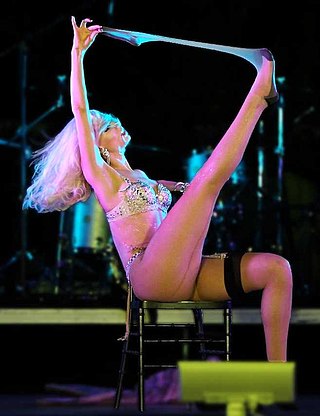
A striptease is an erotic or exotic dance in which the performer gradually undresses, either partly or completely, in a seductive and sexually suggestive manner. The person who performs a striptease is commonly known as a "stripper" or an "exotic" or "burlesque" dancer.

A sex show is a form of live performance that features one or more performers engaging in some form of sexual activity on stage for the entertainment or sexual gratification of spectators. Performers are paid either by the spectators or by the organisers of the show.

A stripper or exotic dancer is a person whose occupation involves performing striptease in a public adult entertainment venue such as a strip club. At times, a stripper may be hired to perform at a bachelor party or other private events.

The Whisky a Go Go is a historic nightclub in West Hollywood, California, United States. It is located at 8901 Sunset Boulevard on the Sunset Strip, corner North Clark Street, opposite North San Vicente Boulevard, northwest corner. The club has been the host for musicians and bands including Taj Mahal, Otis Redding, Hugh Masekela, Alice Cooper, The Doors, The Byrds, Three Dog Night, The Mothers of Invention, Buffalo Springfield, Led Zeppelin, Love, The Stooges, Parliament-Funkadelic, The Beach Boys, Cheap Trick, No Doubt, System of a Down, The Flying Burrito Brothers, Chicago, Germs, Elton John, Oasis, Steppenwolf, Van Halen, Rush, Johnny Rivers, X, Iron Butterfly, Fleetwood Mac, KISS, Guns N' Roses, Death, AC/DC, Golden Earring, Linkin Park, Metallica, Mötley Crüe, Stryper, Dokken, and Phil Seymour.

Go-go dancers are dancers who are employed to entertain crowds at nightclubs or other venues where music is played. Go-go dancing originated in the early 1960s at the French bar Whisky a Gogo located in Juan-les-Pins. The bar's name was taken from the French title of the Scottish comedy film Whisky Galore! The French bar then licensed its name to the West Hollywood rock club Whisky a Go Go, which opened in January 1964 and chose the name to reflect the already popular craze of go-go dancing. Many 1960s-era nightclub dancers wore short, fringed skirts and high boots which eventually came to be called go-go boots. Nightclub promoters in the mid‑1960s then conceived the idea of hiring women dressed in these outfits to entertain patrons.

Nana Plaza is an entertainment complex and red-light district in Bangkok, Thailand. Originally built as a shopping center, Nana Plaza occupies a three-story commercial building in the Khlong Toei District of Bangkok about 300 metres (330 yd) from the BTS Skytrain's Nana Station. It describes itself as the "worlds largest adult playground". Its name originates from the influential, property-holding Nana family, Lek Nana being the most prominent member.
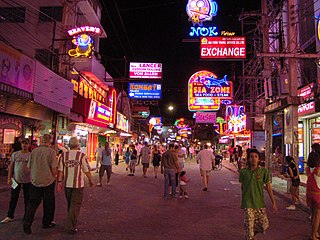
Prostitution in Thailand is illegal. However, due to police corruption and an economic reliance on prostitution dating back to the Vietnam War, it remains a significant presence in the country. It results from poverty, low levels of education and a lack of employment in rural areas. Prostitutes mostly come from the northeastern (Isan) region of Thailand, from ethnic minorities or from neighbouring countries, especially Cambodia, Myanmar, and Laos. UNAIDS in 2019 estimated the total population of sex workers in Thailand to be 43,000.

A strip club is a venue where strippers provide adult entertainment, predominantly in the form of striptease or other erotic dances. Strip clubs typically adopt a nightclub or bar style, and can also adopt a theatre or cabaret-style. American-style strip clubs began to appear outside North America after World War II, arriving in Asia in the late 1980s and Europe in 1978, where they competed against the local English and French styles of striptease and erotic performances.
Sin City is a nickname that may be applied to an urban area that caters to various vices. These vices may be legal or illegal activities which are tolerated.
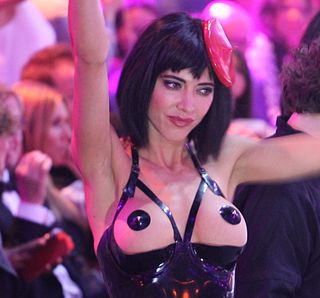
Pasties are patches that cover a person's nipples and areolae, typically self-adhesive or affixed with adhesive. They originated as part of burlesque shows, allowing dancers to perform fully topless without exposing the nipples in order to provide a commercial form of bare-breasted entertainment. Pasties are also, at times, used while sunbathing, worn by strippers and showgirls, or as a form of protest during women's rights events such as Go Topless Day. In some cases this is to avoid potential prosecution under indecency laws.

A ping pong show is a form of stage entertainment that takes place in strip clubs. It is a type of sex show in which women use their pelvic muscles to either hold, eject, or blow objects from their vaginal cavity. Ping pong balls are the most iconic objects used. The show has been popular in Southeast Asia for several decades, and is primarily performed for foreign tourists. The show is in many cases associated with sex tourism and human rights concerns have been raised regarding the performers.
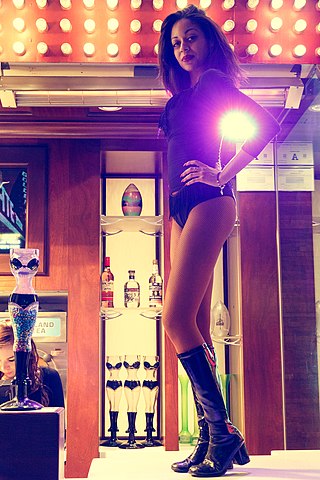
A bargirl is a woman who is paid to entertain patrons in a bar, either individually or, in some cases, as a performer. The exact nature of the entertainment varies widely from place to place; depending on the venue this can be individual entertainment ranging from light conversation to sexual services, or more public entertainment in the form of go-go dancing or striptease. Variants on the term include "B-girl", "hostess", and "juicy girl".

The Condor Club nightclub is a striptease bar or topless bar in the North Beach section of San Francisco, California The club became famous in 1964 as the first fully topless nightclub in America, featuring the dancer Carol Doda wearing a monokini.

R&R, military slang for rest and recuperation, is an abbreviation used for the free time of a soldier or international UN staff serving in unaccompanied duty stations. The term is used by a number of militaries such as the United States Armed Forces and British Armed Forces. In the UK, the term applies to a type of leave granted to personnel during an overseas deployment which allows them to return home to the UK to visit their family.

A nightclub is a club that is open at night, usually for drinking, dancing and other entertainment. Nightclubs often have a bar and discothèque with a dance floor, laser lighting displays, and a stage for live music or a disc jockey (DJ) who mixes recorded music. Nightclubs tend to be smaller than live music venues like theatres and stadiums, with few or no seats for customers.
The legal status of striptease varies considerably among different countries and the various jurisdictions of the United States. Striptease is considered a form of public nudity and subject to changing legal and cultural attitudes on moral and decency grounds. Some countries do not have any restrictions on performances of striptease. In some countries, public nudity is outlawed directly, while in other countries it may be suppressed or regulated indirectly through devices such as restrictions on venues through planning laws, or licensing regulations, or liquor licensing and other restrictions.
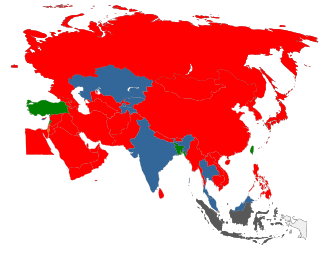
Prostitution in Laos is regarded as a criminal activity and can be subject to severe prosecution. It is much less common than in neighbouring Thailand. Soliciting for prostitution takes place mainly in the city's bars and clubs, although street prostitution also takes place. The visibility of prostitution in Laos belies the practice's illegality. As of 2016, UNAIDS estimates there to be 13,400 prostitutes in the country.

Walking Street is an entertainment and red-light district in the city of Pattaya, Thailand. The street is a tourist attraction which draws both foreigners and Thai nationals primarily for its night life. The Walking Street area includes seafood restaurants, live music venues, beer bars, discothèques, sports bars, go-go bars, nightclubs and hotels. Tourists are able to watch a variety of sex shows.
















